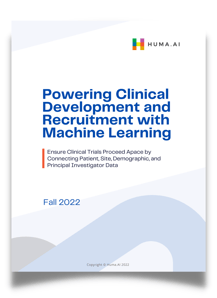Leveraging Clinical Intelligence to Meet New Requirements for Diversity
Properly representing patient populations in clinical trials means taking on many of the toughest challenges in the life sciences today.
The challenges include finding principal investigators with access to diverse patient populations, executing patient recruitment and enrollment, and capturing data that enables clinical professionals to know that a population is diverse enough to be representative of the larger population.
Data that indicate demographics and principal investigators are not easily pooled at present, leaving clinical development professionals in need of a solution.

Knowing the population demographics of the area from which a potential study site draws its participants becomes very useful. Machine Learning can mine insights from demographic data, offering better insight into a trial's diversity based on a site's location and information on the demographics of the region it serves.
According to the New England Journal of Medicine, “In June 2022, the U.S. House of Representatives passed legislation intended to increase the diversity of the populations enrolled in clinical trials of new drugs. Under this bill, study sponsors would be required to submit a diversity action plan — including goals for study enrollment according to demographic group and steps for achieving those goals — for phase 3 or pivotal studies of new drugs.”
The bottom line: an action plan for approaching clinical trial design with diversity in mind is becoming a requirement and a way to enhance the understanding of diseases.
Trials must capture data on critical factors such as race, ethnicity, and gender to ensure that the study population accurately reflects the general population's diversity.
9 Ways to Design Trials for Diversity from the Start
The work being done to ensure that underrepresented populations are correctly accounted for in clinical trial design is extensive.
Here are nine key considerations when seeking diversity in clinical trial design:
- Clinical professionals must be mindful of cultural considerations in developing study protocols and understanding how different communities may respond to treatment based on their beliefs and values.
- The local context in which a trial is conducted must be recognized. This means understanding the demographics of the population being served and other factors, such as geographical and environmental conditions, that may impact outcomes.
- Organizations and individuals working in clinical trials must better collaborate across different fields and disciplines, sharing ideas and expertise to develop comprehensive strategies for ensuring diversity in clinical trials.
- Patients must be engaged in the process of trial design so that they feel comfortable actively participating in the trial and sharing their experiences and feedback throughout.
- Trial sites must be accessible and convenient for potential participants, so data about demographics in regions of interest is critical.
- A clear plan for how data on race, ethnicity, and other diversity-related factors will be collected and analyzed must be present so that it can be used to improve future clinical trials.
- A culture of continuous learning and improvement must be cultivated to ensure that trials are responsive to a rapidly changing world and evolving patient needs.
- Any approach must recognize the complexity and challenges inherent in gathering data from underrepresented populations.
- An ongoing commitment must be kept to developing innovative methods and tools that better enable clinicians to understand how different communities respond to treatment based on their unique cultural beliefs and values.
Powering Diversity with Technology
Clinical development teams need modern tools and technologies that can help them gather large volumes of high-quality data efficiently and effectively.
These tools can help researchers analyze complex datasets with greater accuracy and precision, allowing them to make more insightful decisions about trial design. Overcoming the data challenges of diversity is critical for delivering effective treatments for a wide range of diseases, helping improve health outcomes for people worldwide.
By leveraging advances in machine learning, researchers can gain deeper insights from diverse datasets and make better predictions about how different patient populations will respond to treatment.
According to an article in Contemporary Clinical Trials, "Improving diversity in clinical trials is essential in order to produce generalizable results. Although the importance of representation has become increasingly recognized, identifying strategies to approach this work remains elusive."
There are many ways that machine learning can be used to analyze demographic data to understand clinical trial populations better.
One method uses machine learning algorithms to predict the probability that a given individual will participate in a clinical trial based on information such as age, gender, race, and disease type. This can identify which subpopulations are underrepresented in clinical trials and target recruitment efforts accordingly.
Another approach is to use machine learning to identify clinical trial participants' demographic data patterns to understand better which factors are associated with higher or lower participation rates. This information can then be used to make changes to the design or conduct of clinical trials to increase participation from underrepresented groups.
The use of machine learning can significantly improve our understanding of how different demographics affect participation in clinical trials and make sure that these trials are more representative of the populations they aim to serve.
A great deal of work still needs to be done in this area. Still, the potential benefits of using machine learning to increase diversity in clinical trials are clear and demand exploration.
Want Deeper Clinical Trial Insights?
Finding the sites and principal investigators to conduct trials is no small task.
With Huma.AI , however, a single intelligence layer is placed over a wide variety of data sets pulled from almost any source.
Huma.AI uncovers deeply buried clinical trial insights that give clinical professionals the highly targeted intelligence and market advantage needed to create more successful trials.
Book a free demo to see how Huma.AI can boost your clinical intelligence.
.png?width=300&height=120&name=Huma-AI-Logo-(Horizontal).png)



.png?width=200&name=Huma-AI-Logo-(Horizontal-Reverse).png)